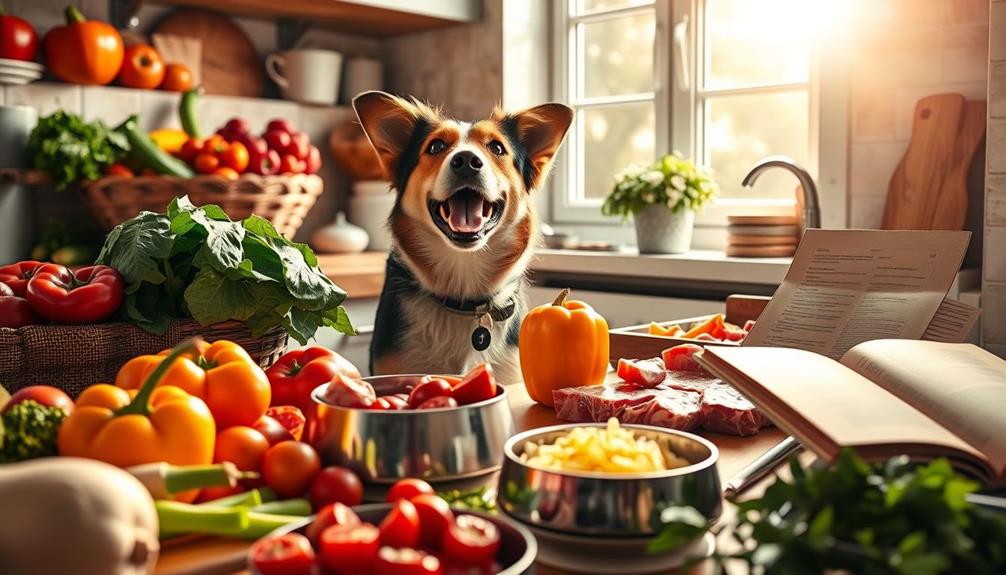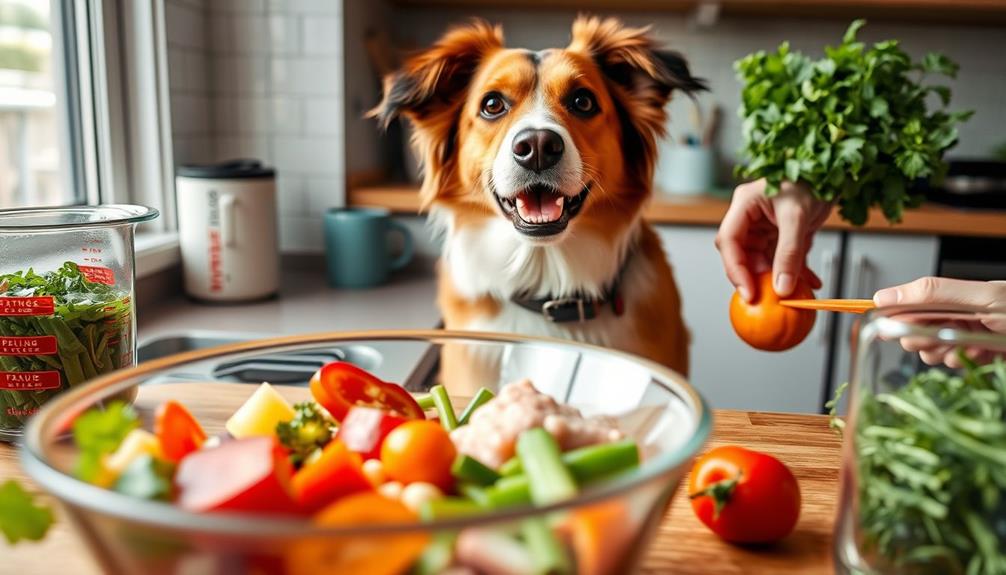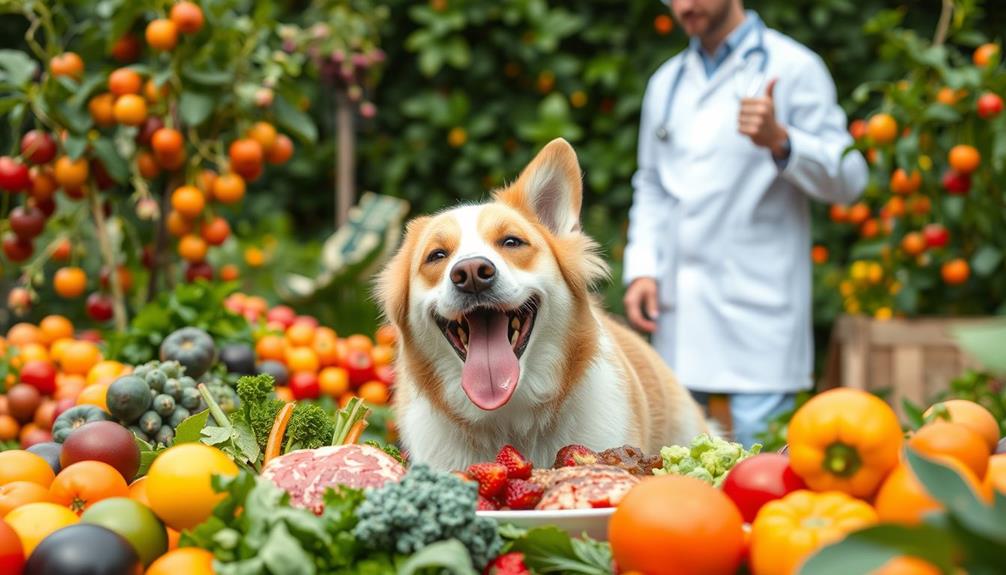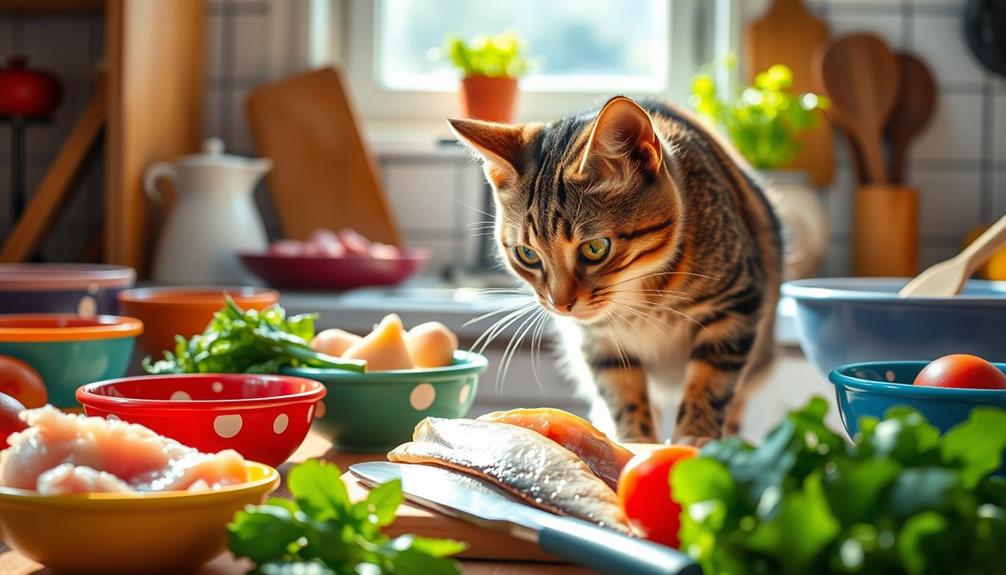Starting a raw food diet for your dog can be straightforward and rewarding. Begin by understanding that a balanced raw diet includes muscle meat, organ meats, and bones. Gradually introduce raw food over 7-10 days, starting with 25% raw mixed into their current food. Confirm you're sourcing high-quality, USDA-certified meats and practicing safe handling to prevent pathogens. Monitor your dog's response, adjusting the diet as needed, while maintaining a consistent feeding schedule. Keep an eye on their health indicators, like energy and coat condition. There's more to explore about raw feeding practices and benefits, so keep going! Research the benefits of raw food for dogs, such as improved digestion, healthier coat and skin, and increased energy levels. Many pet owners find that their dogs thrive on a raw food diet, experiencing fewer allergies and sensitivities. With the right knowledge and resources, you can provide your dog with a nutritionally balanced raw food diet that supports their overall health and well-being. Explore different raw food options and consult with a veterinarian to ensure you’re meeting your dog’s specific dietary needs.
Key Takeaways
- Gradually transition to raw food over 7-10 days by mixing 25% raw with the current diet and increasing the proportion steadily.
- Ensure a balanced diet following BARF guidelines, including muscle meat, organ meats, bones, and fruits/vegetables for optimal nutrition.
- Source high-quality meats from reputable suppliers and practice safe food handling to prevent pathogens.
- Monitor your dog's health indicators such as coat condition, energy levels, and stool quality to adjust the diet as needed.
- Consult with a veterinarian for personalized guidance and to confirm nutritional adequacy throughout the transition to a raw diet.
Understanding Raw Dog Food
Raw dog food is a diet that aims to mimic what your dog's wild ancestors would have eaten, focusing on uncooked ingredients like raw meat, organs, connective tissue, and bones. This approach aligns with your dog's natural dietary needs, allowing them to thrive on a balanced raw diet.
When feeding raw meat, it's important to include a variety of proteins to guarantee your dog gets all necessary nutrients. Proper nutrition is vital for overall health, similar to how ultimate hamster care emphasizes a balanced diet for small pets.
A balanced raw diet incorporates muscle meat, organ meats, and bones, preventing nutritional deficiencies that could arise from feeding solely muscle meat. Dogs can safely digest raw meat due to their strong stomach acid and digestive enzymes, making cooking unnecessary and potentially detrimental to nutritional value.
Benefits of a Raw Diet
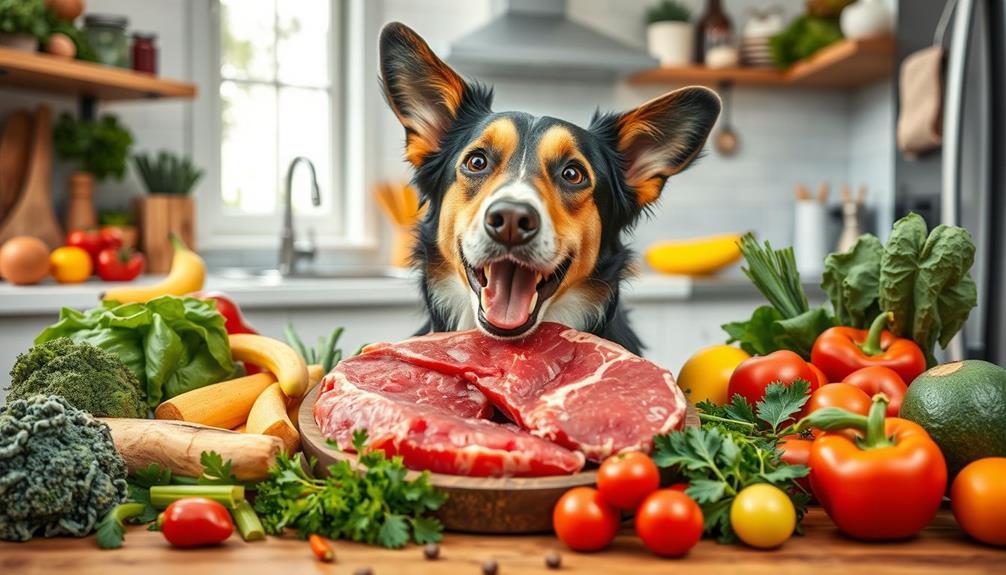
Switching your dog to a raw diet can yield numerous benefits that improve their overall health and vigor. Many dog owners notice significant improvements after making the switch, thanks to the nutrient-rich nature of feeding dogs raw. Here are some key benefits of a raw diet:
| Benefit | Description | Impact on Your Dog |
|---|---|---|
| Digestion | Promotes better absorption, leading to smaller stools | Improved comfort and health |
| Coat Health | Higher moisture and healthy fats enhance skin and fur | Shiny, healthy coat |
| Energy Levels | Natural, unprocessed ingredients boost liveliness | More playfulness and stamina |
| Dental Health | Chewing raw proteins and bones reduces plaque | Healthier teeth and gums |
Additionally, a balanced raw diet can help reduce allergies and sensitivities. Many dogs experience fewer food-related reactions when their meals are nutrient-dense and aligned with their natural dietary needs. By focusing on these benefits of raw, you'll likely see a happier, healthier dog who enjoys a more vibrant life.
Safety and Quality Concerns

When starting a raw food diet for your dog, safety should be a top priority. You need to guarantee the meat you use is free from harmful pathogens and sourced from quality suppliers.
Incorporating fresh herbs, like chamomile and ginger, can't only enhance flavor but also provide additional health benefits. By choosing high-quality ingredients and following proper handling practices, you can keep your dog healthy and safe.
Raw Meat Safety
Guaranteeing safety and quality in a raw food diet for dogs involves careful consideration of meat handling and sourcing. Raw meat safety is vital, as potential pathogens like Salmonella, E. coli, and Listeria can pose serious health risks. To mitigate these risks, it's important to be aware of common types of cold medications that can impact your dog's health, especially if they're sick.
Focus on proper handling techniques. Always wash your hands and surfaces thoroughly after dealing with raw meat, and use separate utensils and cutting boards to prevent cross-contamination.
When selecting raw dog food, aim for high-quality ingredients sourced from reputable suppliers, ideally those certified by the USDA. This minimizes the risk of contamination and guarantees your pup gets the best nutrition possible.
Store raw meat in the freezer to avoid spoilage, and always thaw it in the refrigerator—not at room temperature.
Regularly clean your dog's feeding bowls and monitor for any signs of spoilage or food intolerance, as these can affect health. By adhering to these guidelines, you can help guarantee that your dog stays healthy and safe while enjoying the benefits of a raw food diet.
Quality Ingredient Sourcing
Sourcing high-quality ingredients is fundamental for maintaining the safety and nutritional integrity of your dog's raw food diet. Start by prioritizing high-quality meats from reputable suppliers, ideally from USDA-certified sources. This guarantees that you're providing your dog with the best possible protein.
Investigate each supplier's food safety practices, looking for certifications that verify their adherence to hygiene and quality standards. Additionally, incorporating nutrient-rich ingredients like chia seeds can enhance your dog's diet due to their high fiber and omega-3 content.
Consider raw dog food products that utilize High-Pressure Processing (HPP). This method neutralizes pathogens while preserving the food's nutritional value. When planning meals, incorporate diverse protein options by rotating between at least three different meats. This approach not only promotes balanced nutrition but also reduces the risk of allergies.
Don't forget to include organic fruits and vegetables in your dog's diet. Verify these produce items are pesticide-free to maximize health benefits and minimize exposure to harmful chemicals.
Transitioning to Raw Food

How can you smoothly alter your dog to a raw food diet? Start by gradually introducing raw food over a 7-10 day period. Begin with a 25% raw food mix and slowly increase it to 100%.
During this shift process, it's essential to monitor your dog's response. Keep an eye out for any signs of digestive issues, and adjust portion sizes according to your dog's appetite.
Incorporating new dietary changes can be challenging, so seeking advice on financial considerations for elderly care can help you manage any associated costs.
For dogs with sensitive stomachs, consider alternating meals between their old food and the new raw diet to ease the change. This can help minimize any potential digestive upset.
Additionally, maintain a consistent feeding schedule to support your dog's adjustment; feeding them at the same times each day reinforces routine and stability.
Don't hesitate to consult with a veterinarian or a pet nutritionist for personalized guidance. They can address any specific concerns and help you navigate the shift to a raw food diet safely.
Choosing Raw Dog Food
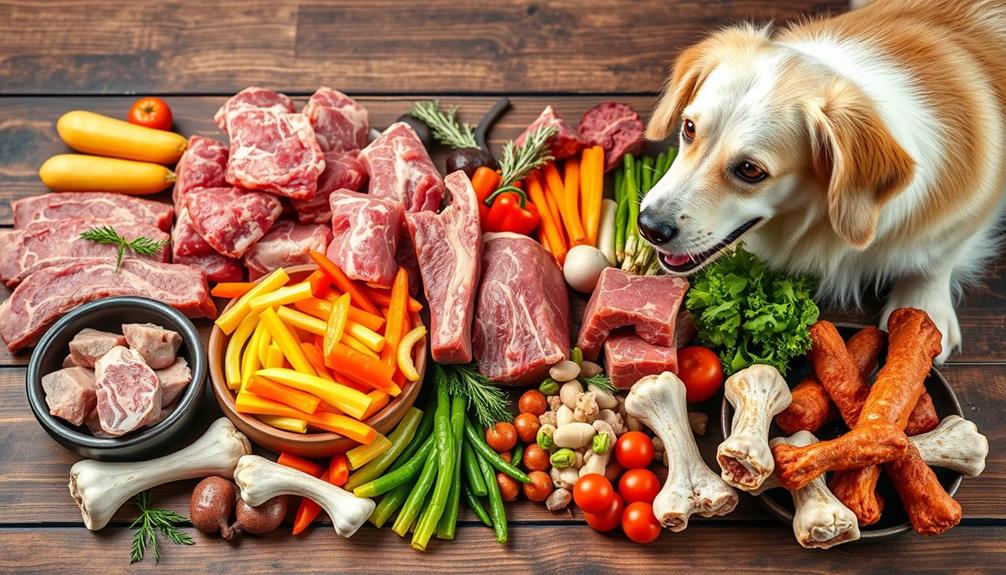
When it comes to choosing raw dog food, you want to guarantee it provides a complete and balanced diet. Following the BARF diet guidelines, aim for a mix of 64% high-quality meats, 8% bones, 8% organ meats, and 20% fruits and vegetables. Selecting fresh, reputable protein sources is essential; avoid processed ingredients that could compromise your dog's health.
Additionally, consider the benefits of including antioxidant-rich foods in your dog's diet to support their overall health and wellbeing.
Consider rotating at least three different protein sources to guarantee a well-rounded nutritional profile. It's also important to understand your dog's specific nutritional needs, including any allergies to common proteins like beef or chicken. Organ meats like liver and heart are significant, making up 10% and 5% of the diet, respectively.
Before committing to any brand, investigate their food safety practices. Look for companies that source ingredients from USDA-certified suppliers and employ methods like High-Pressure Processing (HPP) to eliminate pathogens without losing nutrition.
To simplify the process of feeding your dog a balanced raw diet, explore raw food subscription services, which offer convenience, variety, and expert guidance tailored to your dog's needs.
Managing Your Dog's Diet
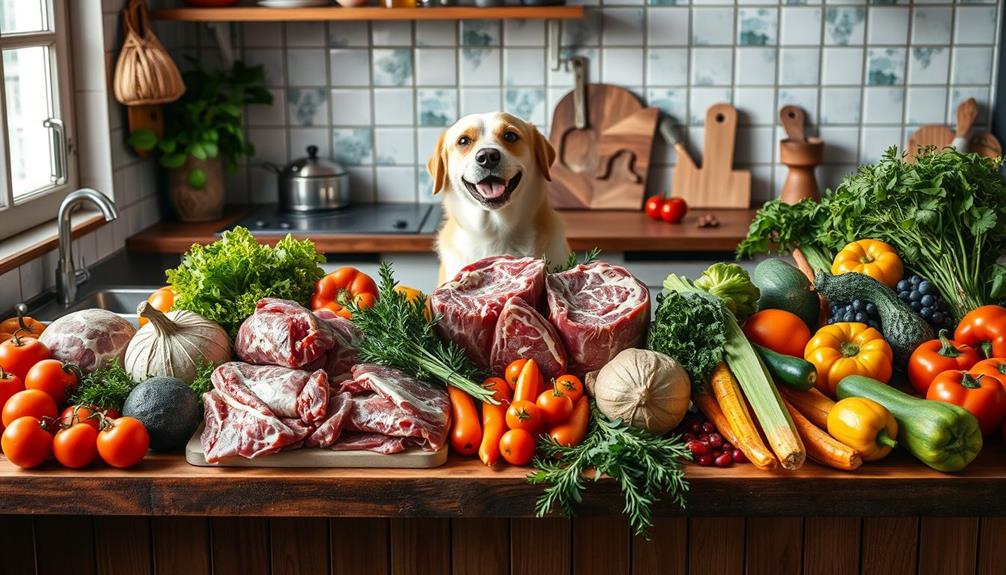
Managing your dog's diet is vital for their health and wellbeing. To effectively do this on a raw food diet, start by feeding them 2-3% of their ideal body weight daily. For example, a 100-lb dog would eat about 2-3 lbs. Adjust these feeding amounts based on your dog's activity level and life stage to maintain a balanced ratio.
Aim for 64% meat, 8% bones, 8% organ meats, and 20% fruits and vegetables to guarantee they receive all essential nutrients. Incorporating healthy dog snacks can also provide additional nutrition and keep your pet satisfied throughout the day.
To shift your dog to a raw food diet, do it gradually over 7-10 days. Start with a 25% raw food mix alongside their current diet, increasing the proportion to minimize digestive upset.
It's critical to monitor health during this shift by observing changes in coat condition, energy levels, and stool quality. These indicators can help you assess how well your dog is adjusting.
Utilize online calculators or quizzes from raw food brands to determine tailored feeding amounts that confirm nutritional adequacy. Remember, it's important to adjust your dog's diet as needed to keep them thriving on their new raw food journey.
Frequently Asked Questions
Can I Feed My Dog Raw Vegetables on a Raw Diet?
Yes, you can feed your dog raw vegetables on a raw diet. Just make sure to choose dog-safe options like carrots or spinach, and chop them into small pieces to aid digestion and absorption.
How Do I Know if My Dog Is Allergic to Raw Food?
Identifying allergies in your dog's raw food diet is like solving a mystery. Watch for symptoms such as itching, digestive issues, or skin irritations. If you notice these signs, consult your vet for guidance.
Are There Any Specific Dog Breeds That Shouldn't Eat Raw Food?
Certain breeds, like those with sensitive stomachs or specific health issues, might not do well on a raw food diet. It's best to consult your vet to determine what's safe for your dog's unique needs.
How Often Should I Rotate Proteins in My Dog's Raw Diet?
You should rotate proteins every few days to keep your dog's diet varied and balanced. This helps guarantee they get a mix of nutrients and reduces the risk of developing sensitivities to any single protein source.
Can I Use Store-Bought Raw Food Instead of Homemade?
Yes, you can use store-bought raw food instead of homemade. Just guarantee it meets your dog's nutritional needs and comes from a reputable source. Always check ingredients and consult with your vet for guidance.
Conclusion
Starting a raw food diet for your dog can transform their health and happiness. For instance, Bella, a Labrador with skin issues, thrived after switching to raw food, showing a shiny coat and increased energy. By understanding the benefits, ensuring safety, and altering carefully, you can give your furry friend a diet that supports their natural instincts. Remember, every dog is unique, so observe how your pup responds and adjust accordingly for the best results!

